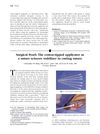 1 citations,
January 1993 in “Facial Plastic Surgery”
1 citations,
January 1993 in “Facial Plastic Surgery” Surgical hair restoration has improved since 1959, with new techniques like minigrafts, micrografts, and scalp reductions creating more natural hairlines and reducing bald skin, despite some risks and potential for scarring.
August 2024 in “BENTHAM SCIENCE PUBLISHERS eBooks”  January 2024 in “Springer eBooks”
January 2024 in “Springer eBooks” Modern hair restoration techniques offer natural results with minimal complications.
 July 2023 in “The journal of investigative dermatology/Journal of investigative dermatology”
July 2023 in “The journal of investigative dermatology/Journal of investigative dermatology” Assessing CD8+ T cell levels before surgery may improve vitiligo treatment outcomes.
 June 2023 in “Journal of Cosmetic Dermatology”
June 2023 in “Journal of Cosmetic Dermatology” The new follicular unit extraction treatment effectively treats severe hair loss in Asian men, giving natural-looking results with few side effects.
 May 2023 in “Aesthetic Plastic Surgery”
May 2023 in “Aesthetic Plastic Surgery” The document concludes that there are various surgical techniques for hair restoration, their success depends on the surgeon's skill, patient's health, and quality of donor hair, and they can potentially improve the mental well-being of those with hair loss.
 April 2020 in “The FASEB Journal”
April 2020 in “The FASEB Journal” Surgical and chemical castration have varied effects on heart and brain inflammation and artery function in sick rats.
Hair transplantation is a surgical treatment that uses your own hair to fill areas with thin or no hair.
 January 2019 in “Springer eBooks”
January 2019 in “Springer eBooks” Transplanting skin cells is a safe, effective, and affordable treatment for vitiligo.
Hair transplantation showed the most promise for repigmenting white hair, especially for eyebrows and eyelashes.

Surgical hair restoration can be done without hair transplantation.
 January 2017 in “Elsevier eBooks”
January 2017 in “Elsevier eBooks” The document concludes that choosing the right forehead and brow lifting technique based on individual patient characteristics is crucial to prevent complications and achieve desired results.
Methods to restore hair medically and surgically exist.

Non-transplantation methods can effectively restore hair.

A robotic device could improve surgical hair restoration, but it needs more testing to confirm its effectiveness compared to current methods.

Robotic-assisted hair transplant is effective and less painful, but needs more evaluation for long-term results.
 September 2013 in “Hair transplant forum international”
September 2013 in “Hair transplant forum international” The assistant's job is to represent and explain the field of hair restoration.
 September 2011 in “Hair transplant forum international”
September 2011 in “Hair transplant forum international” Designing the hair transplant area is important for a successful surgery.
 February 2010 in “Journal of The American Academy of Dermatology”
February 2010 in “Journal of The American Academy of Dermatology” Surgery on a baby with a skin disorder improved eyelid position and eye health.
 April 2009 in “Dermatologic Surgery”
April 2009 in “Dermatologic Surgery” The document concludes that the first book on mesotherapy lacks convincing evidence, the second book is good for beginners in facial rejuvenation, and the third book is valuable for understanding complications in skin surgery.
 March 2009 in “Hair transplant forum international”
March 2009 in “Hair transplant forum international” The document's conclusion cannot be provided because the content is not accessible.
September 2008 in “Hair transplant forum international” Prioritizing cost over expertise in hair restoration can lower care quality.
 November 2007 in “Hair transplant forum international”
November 2007 in “Hair transplant forum international” The document's conclusion cannot be provided because the content is not available to parse.
 September 2007 in “Hair transplant forum international”
September 2007 in “Hair transplant forum international” Wounds kept moist heal faster than dry ones.
 September 2007 in “Hair transplant forum international”
September 2007 in “Hair transplant forum international” The document's conclusion cannot be provided because the document is not accessible or understandable.

Surgical repigmentation can permanently restore color to white hair in vitiligo patients.
 July 2005 in “Journal of The American Academy of Dermatology”
July 2005 in “Journal of The American Academy of Dermatology” Using a cotton-tipped applicator as a base for cutting sutures helps make them a uniform length and reduces the risk of skin cuts.
 July 2004 in “Hair transplant forum international”
July 2004 in “Hair transplant forum international” The document's conclusion cannot be summarized because the content is not accessible or understandable.
May 2004 in “Hair transplant forum international”  October 2002 in “Dermatologic Surgery”
October 2002 in “Dermatologic Surgery” The document concludes that careful planning, efficient use of every hair graft, and setting surgical priorities are crucial for successful hair restoration surgery.























